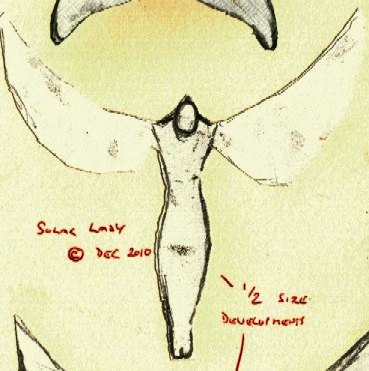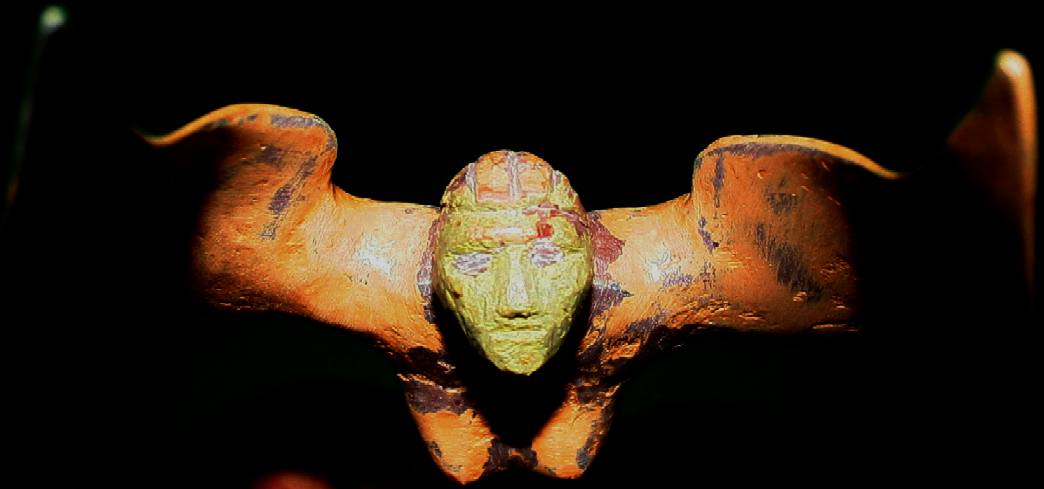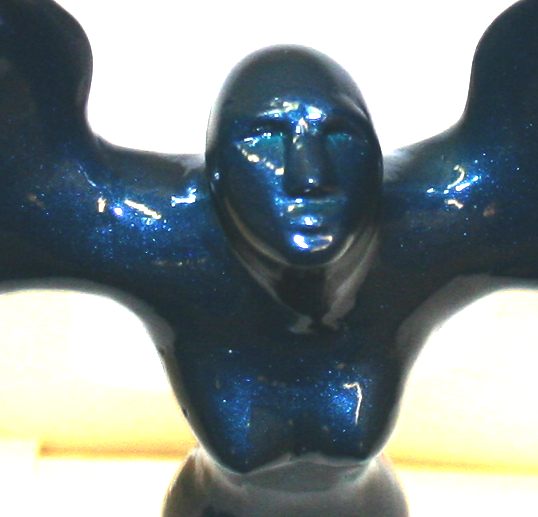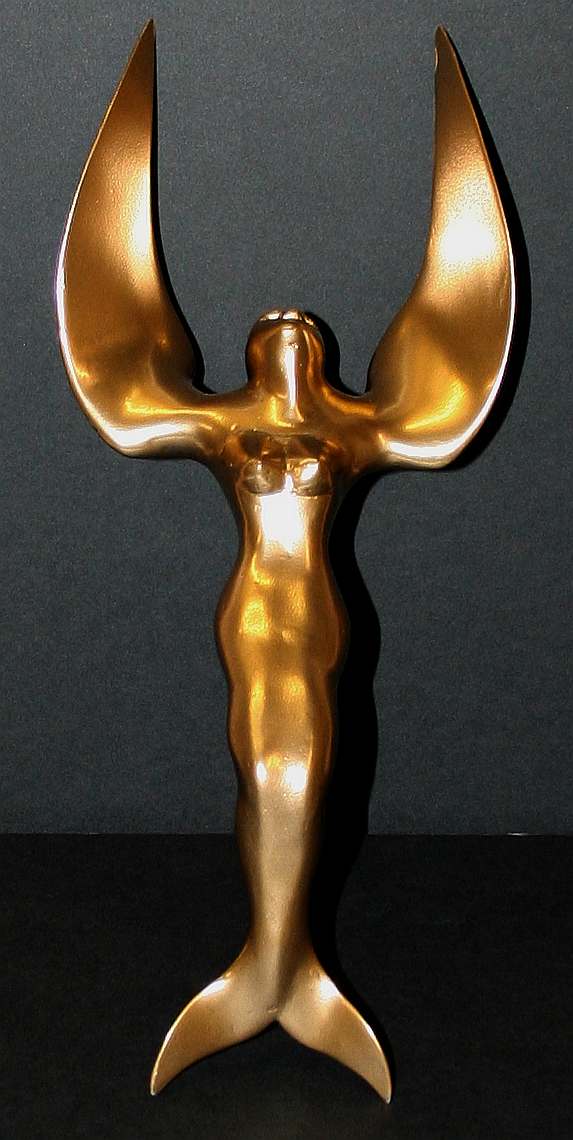|
THE SOLAR LADY - FIGUREHEAD STUDY
|
|||||||||||||||||||||||||||||||||||||||||||||||||||||||||||||||||||||||||||||
|
She had the right shape head, perfect skin and eye colouring to produce the Cleopatra feel we are looking to create.
We have to capture this look photographically then take a mould of Christina's face, which will then be painted to match the make-up of the famous Egyptian Queen. That will be the basis for the Solar Lady's face.
Many famous actors and actresses have to go through this experience when Madame Tussards make a wax model for their famous displays.
An important ship often has an elaborate figure, usually carved from wood - and typically a maiden in all her glory - attached to the bows or prow of the vessel to bring good luck to a crew on their voyages, act as an inspiration to others and lead the way.
The angels wings are to symbolize the solar panels (solar wings) of the ship, so were formed from flat sheets folded. There is an upper and lower wing, which on the full size sculpture will be welded together in stainless steel, carved from wood or steam folded from wooden laminate. Note the under wing below and left. It is only when folded together that the true beauty of the sculpture is revealed. Not shown here as it was completed in 2011 because the piece was left in an unheated workshop/store with a gap under a door - and a mouse (or mice) ate most of the body over the harsh 2012 winter. We can't begrudge the poor old mouse it's meal, if it was that hungry. The study is being repeated in alloy and reinforced resin-glass - seen below.
In the case of Solar Navigator, the ship is a technological masterpiece and a graceful interface between man and nature, thus a fair maiden suitably blended with representative technology and in this case mythological creatures if thought to be truly representative of the aims of the group of companies and academics currently supporting the project: she is an angel from the Northern hemisphere; the Angel of the South (of England).
A stunning figurehead for the Solar Navigator is being produced to reflect both the traditional and modern aspects of the stated objectives - including the world's first artificially intelligent autonomous navigation, including many robotic functions, such as automatic energy harvesting optimization. Our artist accepts both private and corporate art commissions and may be contacted via this website by simply emailing our webmaster. These are pictures of the latest development study from May 2013:-
The alloy is roughened to give a nice key to the resin and matt, which is much harder to work than clay - you have to be lightning fast with a sharp knife to trim roughly while it is soft. Once cured the composite can be carved like a hardwood. We'd like to see the mouse that can chew through this one. Just as when working with clay, more layers will be added. We are trying epoxy putty for this scale art, which study is 280mm from fin to wing tips - the perfect size for the next Solar Navigator tank test model, presently under construction - and also something of a work of art. As far as we know this is the first model of a full size boat, to be fitted with a model figurehead.
Above, is the sculpture with a the head block (rough) carved looking very gargoyle like. The epoxy putty turned out not to be such a good idea. It took too long to cure, and when cured was bitty, so that when carving fine detail, chunks came out and the features were lost. It was decided to recover by removing the putty and using glass and resin to build up a nice solid substrate to carve. On a full size work, wooden blocks are typically bonded together to form a blank, from which to carve. The picture above shows the face in epoxy putty as of 1st June 2013 - that did not allow fine detail carving.
The completed sculpture is given a coat of blue paint as the base for gold (June 6th 2013). The color blue was perfected by the Ancient Egyptians in the 4th Dynasty (2575-2467 BC). The term for it in the Egyptian language is hsbd-iryt. Gold plating or gold-leaf would have been preferred, but cost considerations rule that out for the 1/20th study piece. The full size work should look suitably commanding on the Solar Navigator ship at 5.80 meters, whether in white or gold leaf. At that scale we can carve a likeness to the real life model seen at the head on this page - near impossible at this scale where the wings prevent all round access for chisels. The face on the sculpture at the moment looks like one of the Prometheus aliens. The Solar Lady would make an interesting engineering challenge at 28 meters (94ft), as the Angel of the South counterpart to the Angel of the North.
The gold paint has accentuated the Ancient Egyptian quality of this maritime guardian angel. The sculpture is reminiscent of Horus the bird headed god. Indeed, when the concept was emerging, a number of birds of prey were drawn. The first study (the one the mice ate) had the head of an eagle, stylized as the head of a woman. Please note that this design is Copyright © 2010 NJK, with all rights reserved. This art-piece may not be reproduced as a model, statue or other artwork in any scale without the prior written permission of the artist. If you wish to feature the photographs, they must be marked as Copyright, with an attribution and a link back to this page. If these requirements are not observed, the use of any of these pictures will be seen as a breach of copyright here asserted, as defined by the Copyright, Designs and Patents Act 1988.
Finally, the Solar Lady (small scale study) is offered up to the approximate position that she will occupy on the development robot boat. The robot boat is a 1/20th scale model of the full size ship that the 5.1 meter Solar Lady will guide through unsettled seas. Both the model, and full size ship are to be constructed in aluminium alloys. As you can see from the pictures above, the Solar Lady on these pages has a base of aluminium. It has been suggested that a larger Solar Lady sculpture might be carved and cast in solid gold. We will work out how much the gold might cost before committing ourselves.
THE HISTORY OF FIGUREHEADS
Although earlier ships had often had some form of bow ornamentation (e.g. the
Viking ships of ca. A.D. 800–1100), the general practice
of adorning a vessel with a carved figure was introduced with the galleons of the 16th century, as the figurehead as such could not come to be until
ships had an actual
stem-head structure on which to place it.
It is still common practise for warships to carry ships' badges, large plaques mounted on the superstructure with a unique design relating to the ship's name or role. For example Type 42 Destroyers of the Royal Navy, which are named after British cities, carry badges depicting the coat of arms of their namesake.
To sink without a Kaboutermanneke condemned the sailor's soul to haunt the sea forever, so Dutch sailors believed. A similar belief was found in early Scandinavia/Vikings.
Magnificent conceptually and proportionally - The figureheads from the Imperator (left) & USS Lancaster (right)
MARITIME MUSEUM PARIS
The Musée national de la Marine (National Navy Museum) is a maritime museum located in the Palais de Chaillot, Trocadéro, in the XVIe arrondissement of Paris. It has annexes at Brest, Port-Louis, Rochefort (Musée National de la Marine de Rochefort), Toulon and Saint-Tropez. The permanent collection originates in a collection that dates back to Louis XV of France and is truly inspirational for any artist contemplating carving a figurehead. Much of the thought gathering for the Solar Lady has come from a tour of Paris.
In 1748, Henri-Louis Duhamel du Monceau offered a collection of models of ships and naval installations to Louis XV of France, with the request that the items be displayed at the
Louvre and made available to students of the Naval engineers school, which Duhamel headed. The collection was put on display in 1752, in a room of the first floor, next to the Academy of Sciences; the room was called "Salle de Marine" (Navy room), and was used for teaching.
Young mermaid on the left is not commanding enough, the model on the right has the perfect profile
Britannia Figure head - iconic, curvaceous and proud
LINKS:
Lovelyoldtree.wordpress.com/2013/05/12/nineteenth-century-ship-figureheads Maritime.historysa.com.au/collections/ship-figureheads Bangau-maritime-figureheads-colorful-pattern-of-traditional-fisherman-boats-in-kelantan-malaysia http://pinterest.com/vanillagrilla/maritime-figureheads/ http://en.wikipedia.org/wiki/Figurehead www.pem.org/collections/1-maritime_art_and_history www.gettyimages.co.uk/creative/figurehead-stock-photos www.devonmuseums.net/Plymouth-Naval-Base-Museum/Devon-Museums/ www.superstock.com/search/figurehead www.spain.info/en_GB/reportajes/museos_maritimos_en_espana_descubrir_los_secretos_de_los_oceanos http://www.musee-marine.fr/version_uk.html http://en.wikipedia.org/wiki/Mus%C3%A9e_national_de_la_Marine
The Solar Navigator - SWASSH (Small Waterplane Area Stabilized Single Hull) test model 2012 The latest Solarnavigator is a robot ship designed to be capable of an autonomous world navigation set for an attempt in 2015 if all goes according to schedule. The platform is also ideal for persistent monitoring 365 days year 24/7 - with data streamed back to your command HQ via satellite.
|
|||||||||||||||||||||||||||||||||||||||||||||||||||||||||||||||||||||||||||||
|
This
website is copyright © 1991- 2018 Electrick Publications. All rights
reserved. The bird logo
|
|||||||||||||||||||||||||||||||||||||||||||||||||||||||||||||||||||||||||||||





































